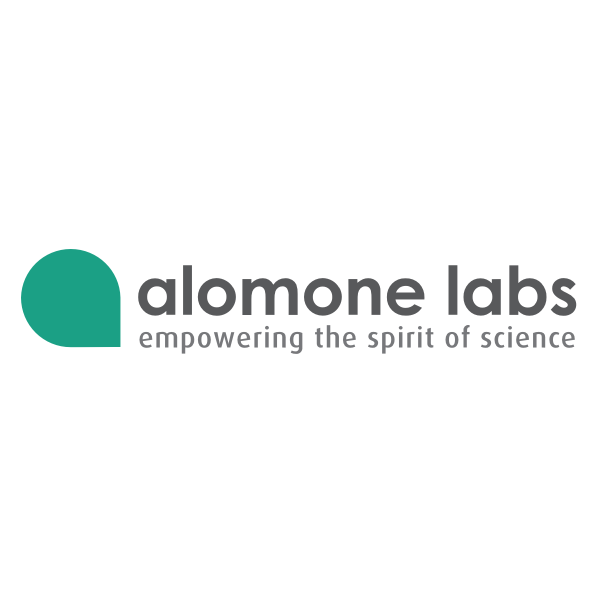 全部商品分类
全部商品分类

品牌: Alomone
 下载产品说明书
下载产品说明书 用小程序,查商品更便捷
用小程序,查商品更便捷


 收藏
收藏
 对比
对比 咨询
咨询纯度:
The serum was depleted of anti-GST antibodies by affinity chromatography on immobilized GST, and then Anti-Aquaporin 4 antibody was affinity purified on immobilized aqp4-GST.
反应种属:
H, M, R
产品介绍
产品信息
纯化方式
The serum was depleted of anti-GST antibodies by affinity chromatography on immobilized GST and then the IgG fraction was purified on immobilized antigen.

宿主
兔

简单描述
A Rabbit Polyclonal Antibody to Aquaporin 4 (249-323) Channel

商品描述
Each antibody ordered from Alomone Labs is supplied with its corresponding control peptide (antigen), free of charge. A Rabbit Polyclonal Antibody to Aquaporin 4 (249-323) Channel

同种型
Rabbit IgG.

纯度
The serum was depleted of anti-GST antibodies by affinity chromatography on immobilized GST, and then Anti-Aquaporin 4 antibody was affinity purified on immobilized aqp4-GST.

组成成分
抗水通道蛋白4多克隆抗体,0.05%叠氮化钠溶液,磷酸盐缓冲液

基因
AQP4

应用
实验应用
ICC, IF, IFC, IHC, WB

反应种属
H, M, R

背景
别名
WCH4, Mercurial-insensitive water channel

背景
Aquaporin 4 (AQP-4) belongs to a family of membrane proteins that allow passage of water and certain solutes through biological membranes. The family is composed of 13 members (AQP-0 to AQP-12).
The aquaporins can be divided into two functional groups based on their permability characteristics: the aquaporins that are only permeated by water and the aquaglyceroporins that are permeated by water and other small solutes such as glycerol. AQP-4 together with AQP-1, AQP-2 and AQP-5 belongs to the first group.1
Little is known about the function of the two newest members, AQP-11 and AQP-12.
The proteins present a conserved structure of six transmembrane domains with intracellular N- and C-termini. The functional channel is a tetramer but each subunit has a separate pore and therefore the functional channel unit, contains four pores.1
AQP-4 is the major membrane water channel in the central nervous system. The channel is expressed in astrocyte foot processes in direct contact with capillary vessels in the brain suggesting a role in water transport under normal and pathological conditions. Indeed, transgenic mice lacking AQP-4 have reduced brain swelling and improved neurological outcome following water intoxication and focal cerebral ischemia. In contrast, brain swelling and clinical outcome are worse in AQP-4-null mice in models of vasogenic (fluid leak) edema caused by freeze-injury and brain tumor, probably due to impaired AQP-4-dependent brain water clearance.2
In addition, it has been recently shown that neuromyelitis optica (NMO), an inflammatory demyelinating disease that selectively affects optic nerves and spinal cord, is caused by the development of an autoantibody directed against AQP-4.3
The aquaporins can be divided into two functional groups based on their permability characteristics: the aquaporins that are only permeated by water and the aquaglyceroporins that are permeated by water and other small solutes such as glycerol. AQP-4 together with AQP-1, AQP-2 and AQP-5 belongs to the first group.1
Little is known about the function of the two newest members, AQP-11 and AQP-12.
The proteins present a conserved structure of six transmembrane domains with intracellular N- and C-termini. The functional channel is a tetramer but each subunit has a separate pore and therefore the functional channel unit, contains four pores.1
AQP-4 is the major membrane water channel in the central nervous system. The channel is expressed in astrocyte foot processes in direct contact with capillary vessels in the brain suggesting a role in water transport under normal and pathological conditions. Indeed, transgenic mice lacking AQP-4 have reduced brain swelling and improved neurological outcome following water intoxication and focal cerebral ischemia. In contrast, brain swelling and clinical outcome are worse in AQP-4-null mice in models of vasogenic (fluid leak) edema caused by freeze-injury and brain tumor, probably due to impaired AQP-4-dependent brain water clearance.2
In addition, it has been recently shown that neuromyelitis optica (NMO), an inflammatory demyelinating disease that selectively affects optic nerves and spinal cord, is caused by the development of an autoantibody directed against AQP-4.3

制备和贮存
溶解方法
25 µl, 50 µl or 0.2 ml double distilled water (DDW), depending on the sample size.

保存方式
The antibody ships as a lyophilized powder at room temperature. Upon arrival, it should be stored at -20°C.
数据库链接
Entrez-Gene ID
25293

UniProt ID
P47863

声明 :本官网所有报价均为常温或者蓝冰运输价格,如有产品需要干冰运输,需另外加收干冰运输费。



